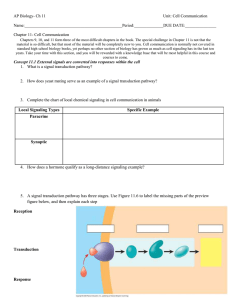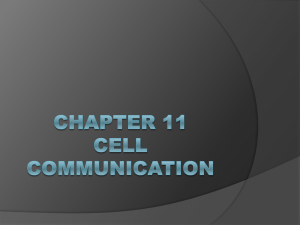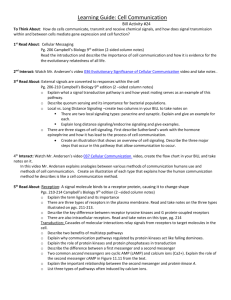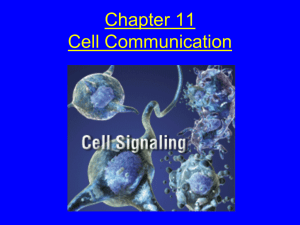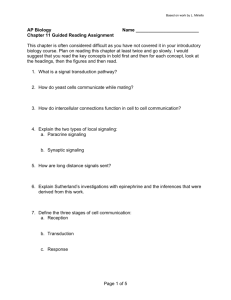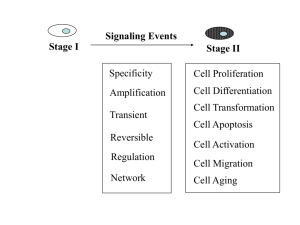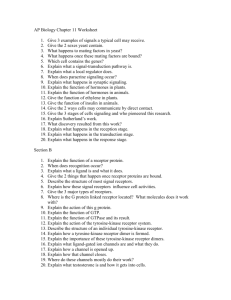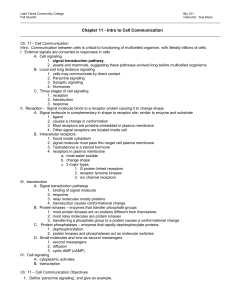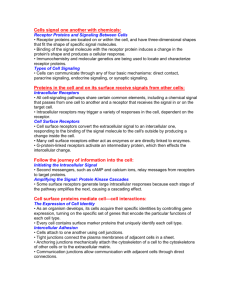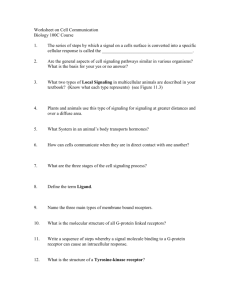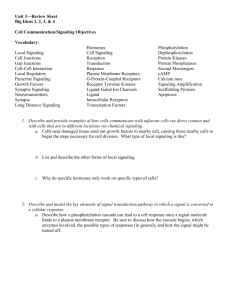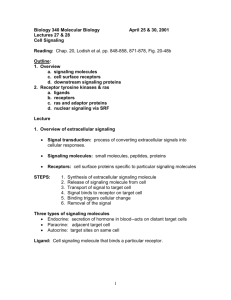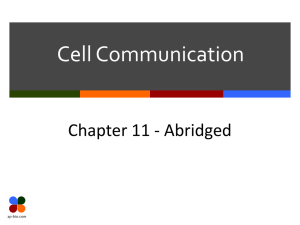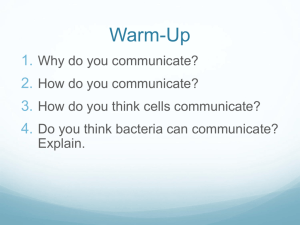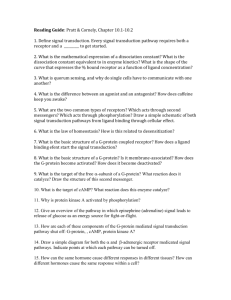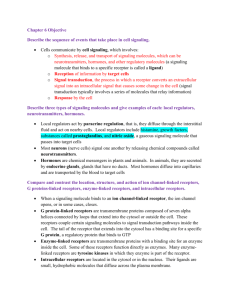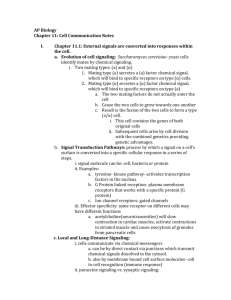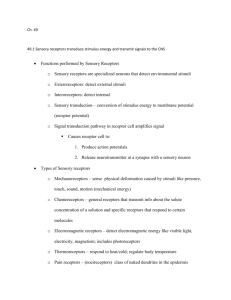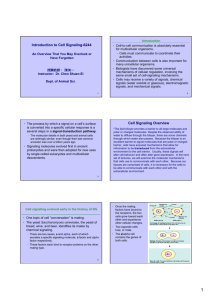Ch. 11 Cell Communication 9th edition
advertisement
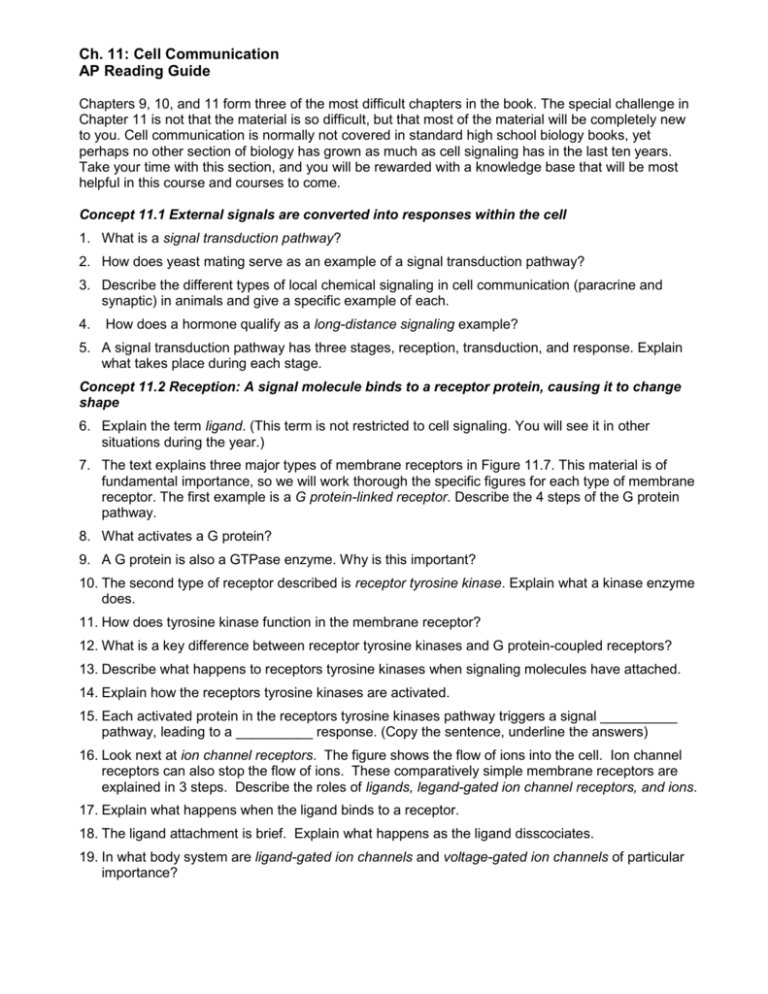
Ch. 11: Cell Communication AP Reading Guide Chapters 9, 10, and 11 form three of the most difficult chapters in the book. The special challenge in Chapter 11 is not that the material is so difficult, but that most of the material will be completely new to you. Cell communication is normally not covered in standard high school biology books, yet perhaps no other section of biology has grown as much as cell signaling has in the last ten years. Take your time with this section, and you will be rewarded with a knowledge base that will be most helpful in this course and courses to come. Concept 11.1 External signals are converted into responses within the cell 1. What is a signal transduction pathway? 2. How does yeast mating serve as an example of a signal transduction pathway? 3. Describe the different types of local chemical signaling in cell communication (paracrine and synaptic) in animals and give a specific example of each. 4. How does a hormone qualify as a long-distance signaling example? 5. A signal transduction pathway has three stages, reception, transduction, and response. Explain what takes place during each stage. Concept 11.2 Reception: A signal molecule binds to a receptor protein, causing it to change shape 6. Explain the term ligand. (This term is not restricted to cell signaling. You will see it in other situations during the year.) 7. The text explains three major types of membrane receptors in Figure 11.7. This material is of fundamental importance, so we will work thorough the specific figures for each type of membrane receptor. The first example is a G protein-linked receptor. Describe the 4 steps of the G protein pathway. 8. What activates a G protein? 9. A G protein is also a GTPase enzyme. Why is this important? 10. The second type of receptor described is receptor tyrosine kinase. Explain what a kinase enzyme does. 11. How does tyrosine kinase function in the membrane receptor? 12. What is a key difference between receptor tyrosine kinases and G protein-coupled receptors? 13. Describe what happens to receptors tyrosine kinases when signaling molecules have attached. 14. Explain how the receptors tyrosine kinases are activated. 15. Each activated protein in the receptors tyrosine kinases pathway triggers a signal __________ pathway, leading to a __________ response. (Copy the sentence, underline the answers) 16. Look next at ion channel receptors. The figure shows the flow of ions into the cell. Ion channel receptors can also stop the flow of ions. These comparatively simple membrane receptors are explained in 3 steps. Describe the roles of ligands, legand-gated ion channel receptors, and ions. 17. Explain what happens when the ligand binds to a receptor. 18. The ligand attachment is brief. Explain what happens as the ligand disscociates. 19. In what body system are ligand-gated ion channels and voltage-gated ion channels of particular importance? 20. Intracellular receptors are found either in the __________ or __________ of target cells. In order to be able to pass through the plasma membrane, the chemical messengers are either __________ or very small, like nitric oxide. (Copy the sentence, underline the answers) 21. Figure 11.9 uses testosterone, a hydrophobic steroid hormone, as an example of how intracellular receptors work. Explain what takes place at each step of the pathway. 22. An important idea, transcription factors, is introduced in Figure 11.8. Explain the function of transcription factors in the cell. Concept 11.3 Transduction: Cascades of molecule interactions relay signals from receptors to target molecules in the cell 23. What are two benefits of multistep pathways like the one in Figure 11.9? 24. Explain the role in transduction of two categories of enzymes: protein kinases and protein phosphatases. 25. Using figure 11.10 as your guide, explain what is occurring at each step of the phosphorylation cascade. 26. What is the difference between the first messenger and the second messenger? 27. Two common second messengers are cyclic AMP (cAMP) and calcium ions (Ca2+). Explain the role of the second messenger cAMP in Figure 11.2. 28. What is the important relationship between the second messenger and protein kinase A? 29. Figure 11.12 explains how a cellular response is initiated; how might that response be inhibited? 30. List three types of cellular responses often induced by calcium ions. Be sure to include a plant example! 31. What happens to the cytoplasmic concentration of calcium when it is used as a second messenger? Concept 11.4 Response: Cell signaling leads to regulation of transcription or cytoplasmic activities 32. When cell signaling causes a nuclear response, what normally happens? 33. When cell signaling causes a cytoplasmic response, what normally happens? 34. Figure 11.16 shows a single molecule of epinephrine resulting in the formation of __________ molecules of glucose 1-phosphate! (Copy the sentence, underline the answer) 35. Figure 11.18 shows four different cellular results from a single signaling molecule. Briefly describe each response. 36. How do scaffolding proteins enhance a cellular response?
